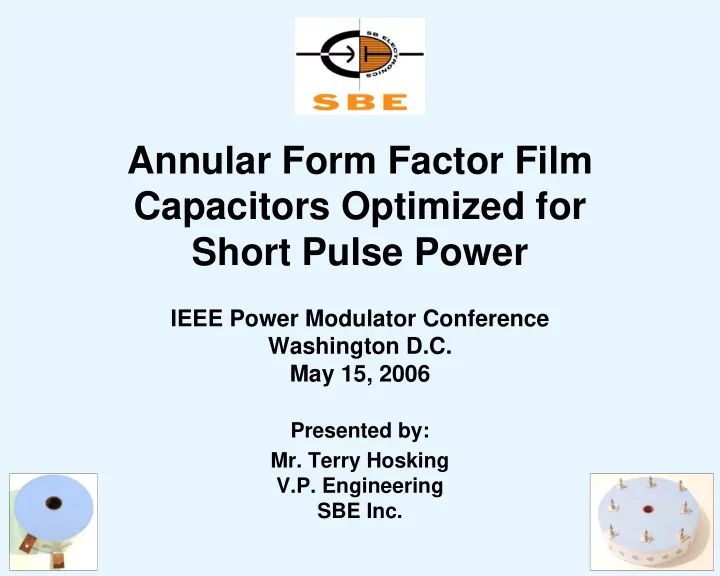

Annular Form Factor Film Capacitors Optimized for Short Pulse Power IEEE Power Modulator Conference Washington D.C. May 15, 2006 Presented by: Mr. Terry Hosking V.P. Engineering SBE Inc.
Acrylate Coated Film vs. SBE’s Patented Pulse Technology Film • Vendor claims 2 to 2.5 times improvement in pulse current performance over traditional metallized polypropylene film. • SBE found no improvement in pulse performance when this acrylate coating was applied to it’s patented pulse technology film design (U.S. Patent #7,008,838).
Performance of Acrylate Coated Film in Annular Form Factor Capacitor • The Power Ring™ was specifically designed with it’s annular form factor to increase pulse current capability. Utilizing SBE’s patented pulse film technology greatly increases this capability. • Premise: Gather data to support even greater improvement using acrylate coated film. • Conclusion: No improvement found. However, other film attributes emerged as critical.
Film Attributes Affecting Pulse Performance • Film metallization material – Reference PPC2005 paper “Annular form factor film capacitors” and SBE patent #7,008,838 • Film metallization thickness • Metallization process consistency at vendor – Poor performance related to less metal (higher resistance)
Test Set-up & Description - Pneumatic shorting contacts with counter & controller - Variable charging supply - TDS420 Oscilloscope for Waveform Analysis
Test Capacitor Description • Metallized Polypropylene Film • 4.5 micron film thickness • 200 μ F • 1500 Volt DC rating • ESL ~ 10 nanohenries (as tested) • ESR < 0.25 milliohms • Form Factor – 1.5” I.D. – 6.0” O.D.
Uncoated Film, Capacitor 1 Capacitance loss vs discharges @ ~increasing peak current 100 24KA 38KA 31KA 44KA Remaining Capacitance [%] 95 50KA 55KA 64KA 90 70KA 73KA 85 Each marker represents the peak test current until next labeled marker 80 75 0 50,000 100,000 150,000 200,000 Discharges This data was used to determine the test current. The "flat“ part of the curve was determined to be a logical reference point, at about 55,000 Amps.
Uncoated Film, Capacitor 2 Capacitance loss vs discharges @ ~55000A peak current 100 Remaining capacitance [%] 95 90 85 80 75 1,000 10,000 100,000 1,000,000 Discharges
Coated Film, Capacitor 1 Capacitance loss vs discharges @ ~55000A peak current 100 Remaining capacitance [%] 95 90 85 80 75 0 10,000 20,000 30,000 40,000 50,000 Discharges
Coated Film, Capacitor 1 Capacitance loss vs discharges @ ~55000A peak current 100 Remaining capacitance [%] 95 90 85 80 75 10 100 1,000 10,000 100,000 Discharges
Initial Observations 1. Coated film did not perform as expected! 2. More parts required testing to ensure repeatability. 3. Additional data points needed at the beginning of each test. 4. Only 10,000 discharges required to evaluate and predict behavior. 5. Physical examination of film indicated heavy edge metallization variance. 6. “Quality” of remaining capacitance remains excellent.
Coated Film, Capacitor 2 Capacitance loss vs discharges @ ~55000A peak current 100 Remaining capacitance [%] 95 90 85 80 75 0 500 1,000 Discharges
Coated Film, Capacitor 2 Capacitance loss vs discharges @ ~55000A peak current 100 Remaining capacitance [%] 95 90 85 80 75 1 10 100 1,000 10,000 Discharges
Coated Film, Capacitor 3 Capacitance loss vs discharges @ ~55000A peak current 100 Remaining capacitance [%] 95 90 85 80 75 1 10 100 1,000 10,000 Discharges
Coated Film, Capacitor 4 Capacitance loss vs discharges @ ~55000A peak current 100 Remaining capacitance [%] 95 90 85 80 75 1 10 100 1,000 10,000 Discharges
Coated Film, Capacitor 5 Capacitance loss vs discharges @ ~55000A peak current 100 Remaining capacitance [%] 95 90 85 80 75 1 10 100 1,000 10,000 Discharges
How Does Data Relate To Industry Applications • 55,000 Amp stress is great for evaluating materials and processes • 10,000 Amps is entirely practical – Test shows less than 2% capacitance loss after 1,000,000 discharges • Capacitor design used here has been supplied for a 2,000 amp repetitive peak current and a 20,000 fault tolerant application.
Uncoated Film, Long Term Reliability Test, 1 Million Discharges Capacitance loss vs discharges @ ~10,000 Amps peak current 100 99 Remaining capacitance [%] 98 97 96 95 94 93 92 91 90 0 200,000 400,000 600,000 800,000 1,000,000 1,200,000 Discharges After the poor performance of the coated part, it was decided to perform a long term reliability test to analyze capacitance stability at a lower pulse current. Testing at 10,000 Amps resulted in only a 1.15% capacitance loss after more than a million discharges.
Future Work • Film Metallization Heavy Edge Alloys, Thicknesses • Long term reliability studies, extensive testing at greater number of discharges, extended test currents
Thank you! Please see us in Booth #6 Mr. Terry Hosking SBE Inc. Tel: 802-476-4146 E-mail: TerryH@SBElectronics.com Web: www.SBElectronics.com
Recommend
More recommend